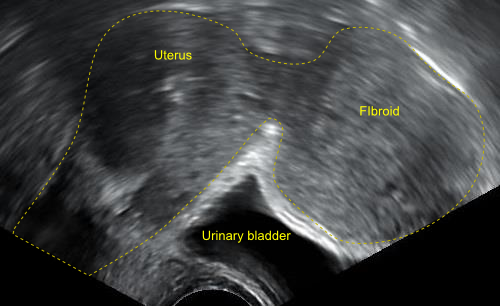It’s a tumour that grows in the smooth muscles of the uterus. It is usually non-cancerous and risk of it turning into cancer is very rare. It can grow under the influence of hormones and shrink in size after menopause.
What are the different types of fibroid?
1. Subserosal-Fibroid can be arising from the outer surface of the uterus where it may not cause much symptoms
2. Intramural-can be present inside the uterine musculature
3. Submucosal– maybe arising inside the endometrial cavity where it requires treatment as it can cause severe menstrual symptoms or infertility
What is the presentation?
- Asymptomatic- some patients don’t have any complaints but we diagnose a fibroid during ultrasound scanning
- Heavy menstrual bleeding
- Pain during menstruation
- Heaviness in the lower abdomen
- Lump in the abdomen
- Infertility of difficulty in conceiving
- Difficulty in passing urine
- Difficulty in bowel movements
- Anemia or low haemoglobin
How do we diagnose?
1.Physical examination
2.Ultrasound scanning of the pelvis
Rarely, MRI ay be required
When do we have to treat?
Patients with no symptoms, or small fibroid or nearing menopause may not require any treatment.
Surgery is suggested:
- Severe menstrual complaints with low haemoglobin
- Failed medical treatment
- Infertility where fibroid is known to be a contributing factor
- Pressure symptoms like urine retention
- Pain abdomen
- Sudden increase in the size of the fibroid
What are the treatment options available?
- Medical
- Traenexamic acid is used to reduce the menstrual blood flow
- Contraceptive pills– are used to reduce the pain and bleeding associated with menstruation but may cause slight increase in the size of the fibroid
- Ulipristal acetate– Is used to Reduce the size of the fibroid as well as it can reduce heavy menstrual bleeding. However, monitoring of the liver function test is required during the treatment course
- GnRh agonist– injections can be used to reduce the size of the fibroid. However, the fibroid can grow back in size after a period of 4-6 months.
- Intrauterine IUD like Mirena can be used to reduce bleeding and pain. However, it wouldn’t reduce size of the fibroid.
- Others- There are other non-surgical treatment options like UAE (blocking the uterine artery blood supply) and usage of USG waves under MRI guidance (to shrink fibroid size). These can be done in selective cases.
Surgical
- Myomectomy or removal of only the fibroid
Done by three routes:
- Laparoscopy- where laparoscope is used along with special instruments, to give a cut on the fibroid, remove the fibroid and suture the uterus. Fibroids are removed in small pieces by incisions less than 1centimeter.
- Hysteroscopy– Where a camera is introduced via the cervix and fibroid is removed by using special instruments called resectoscope.
- Open surgery– Is required for huge fibroids more than 25cm in size and also in suspicion of cancer.
There is a small risk of recurrence of the fibroid after myomectomy.
- Hysterectomy or removal of uterus
Done by laparoscopy or open method
The preferred method of hysterectomy is laparoscopic where the uterus is removed along with the fallopian tubes, with or without the removal of ovaries. The uterus is removed via the vagina and sutured. There is rapid recovery and pain relief with this method. Prolonged bed rest is not required as the incisions are very small.
Open surgery- Is done for large fibroids or suspected ovarian tumour.

